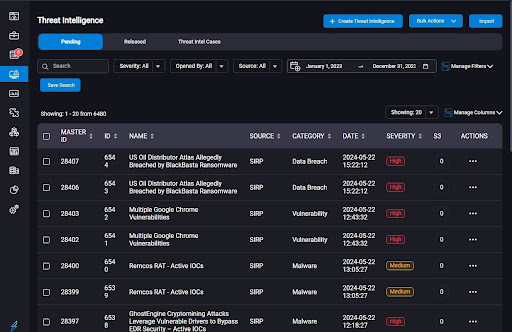
Vulnerability Management on Autopilot: How SIRP Automates Prioritization and Patching
May 21, 2024
Empowering Incident Response: How SIRP Integrates CISA’s NCISS for Better Cybersecurity
November 14, 2024
Vulnerability Management on Autopilot: How SIRP Automates Prioritization and Patching
May 21, 2024
Empowering Incident Response: How SIRP Integrates CISA’s NCISS for Better Cybersecurity
November 14, 2024BLOG
Real-Time Insights, Real-World Protection: Leveraging SIRP's Threat Intelligence for Effective Cyber Defense
Data is one of organisations' most valuable assets, and threat actors can target it and compromise it at any moment. Therefore,to cope with this latest data security challenge organisations need to have a robust threat intelligence system. Cyber threat intelligence (CTI) is essential in enabling organisations to make informed decisions and strategic planning for safeguarding their digital assets. SIRP offers AI-powered threat intelligence, allowing businesses to discover emerging vulnerabilities and cyber threats. SIRP threat intelligence provides indicators of compromise and identifies vulnerabilities for detection of any security incident to perform threat analysis and provides insights to ensure a comprehensive and effective cyber defence system for future.
Threat Intelligence
What is a threat? Threats are any cyber-attacks or malicious activities that could harm an organisation's assets, including organisation's data and personally Identifiable information. Security threats can affect an organisation's operations and financial stability and negatively impact its reputation and customers.
Threat intelligence involves gathering and analysing information related to current or potential security threats. Threat intelligence helps organisations be prepared and protected from any future cyber incident, and CTI also helps to stop and prevent a cyberattack that's in progress.
Threat Intelligence with SIRP
One of the three main features of SIRP Cyber threat intelligence. SIRP empowers businesses to stay ahead of threat actors. SIRP SOAR detects a wide range of vulnerabilities and threats from ransomware and malware to the most sophisticated and latest emerging attacks. By integrating with diverse platforms including open-source and proprietary to provide continuous updates about the threat.
How SIRP’s threat intelligence works. SIRP SOAR integrates with different security controls and various tools and threat intelligence platforms. SIRP’s security controls involve email security, SIEMs and Web Application Firewall. As far as integration with threat intelligence platforms is concerned, SIRP SOAR integrates the following platforms:
1) IBM X-Force
IBM X-Force is a robust threat intelligence platform. Which offers threat research, threat hunting along with real-time threat feeds. X-Force is customizable and focus on different businesses' specific needs and requirements which leads to more efficient approach to threat management.
2) AlienVault Threat Intelligence
A cloud-based threat intelligence platform, caters divers budgets and needs offering free and paid options
3) Crowdstrike
Crowdstrike Falcon Intelligence has automation capabilities by utilizing machine learning. Provides real time threat visibility and reports on vulnerabilities and attacker's TTPs.
4) Talos (Cisco)
Cisco's Talos offers comprehensive analysis and research. It provides rapid, accurate and actionable threat intelligence.
Benefits of SIRP's Threat Intelligence
-
Advanced Threat Detection:
SIRP automatically identifies different threats and provides real-time insights to help businesses. Some examples of actionable insights related to threat detection are below:
a) Indicators of compromise
Through SIRP threat intelligence insights, your analyst gets an understanding into the indicators of compromise used to perform the attack. Security Teams perform threat-hunting against the pertaining indicators to check for their presence in the environment or preemptively block them on their security controls
b) Identification of vulnerabilities
The most common use case of SIRP's threat intelligence is that it helps your organisation's security analyst identify vulnerabilities. Security analysts check the intelligence of threats and analyse the vulnerability, whether the weakness pertains to the organisation or not. If it's related to the organisation, analysts gather more information about the vulnerability or indicators of compromise. After that, an analyst measures risk likelihood. Then, he performs the required actions based on the data. The second use case of SIRP's threat intelligence is to patch those vulnerabilities.
c) Mitigating Global Threats with SIRP
In this digital transformation era, cyber threats surpass logical borders globally ; threat actors can launch attacks from any part of the world. Cyber-attacks could impact a country's national security and their critical infrastructure. SIRP helps to address this challenge and provides you insights about cyber activity with geopolitical region information. SIRP monitors global threat landscape and helps organisations to identify potential threats geographically. This holistic approach allows to detect unauthorised access attempts and helps in mitigating risk from suspicious IP addresses.
d) Emerging Threats
Cyber threats are evolving, and new threats will continue in the cyber security landscape. SIRP SOAR is advanced with artificial intelligence, revolutionising cybersecurity by automating threat intelligence actions and improving speed, accuracy, and efficiency with new emerging vulnerabilities.
-
Enhanced Cyber Defense & Reduced Risk:
SIRP provides informative threat intelligence to strengthen your security practices. With the help of insights provided by SIRP threat intelligence, your organisation's team proactively knows the holes where security gaps may cause an attack. SIRP's threat intelligence capabilities assist businesses in preventing potential data breaches and threats
The primary purpose of SIRP threat intelligence is to enable your security team to block indicators of compromise before any incident happens to make your environment proactively safe.
-
Various Business Benefits of Implementing SIRP
Many enterprises across industries have implemented SIRP's threat intelligence solutions and observed various benefits. Through advanced threat identification, timely incident response and enhanced threat analysis.
a) Automation:
SIRP automates up to 90% of the process of cyber threat intelligence, saving time to facilitate your security team to focus on what matters most and other important security aspects.
b) Regulatory Compliance
SIRP threat Intelligence helps your business meet regulatory compliance requirements proactively and relatively. SIRP CTI can save hundreds of thousands of dollars. In the case of any attack, an incident can lead to regulatory violations and penalties. To comply with cyber security laws, organisations need to tell which type of attack was used and which indicators of compromise were used.
c) Robust Security
With SIRP threat intelligence, businesses can defend their tangible and non-tangible assets, which may reduce the impact of security incidents.
In short, the importance of advanced threat intelligence solutions cannot be denied. SIRP offers a holistic approach towards cyber threat intelligence and delivers actionable insights that enable organisations to safeguard their infrastructure, enhance security posture, and mitigate risks.
Stay ahead of threat actors and proactively step towards strengthening your organisation's cyber defence and protection mechanisms. Safeguard your business, JOIN SIRP - where real-time insights meet real-world protection


